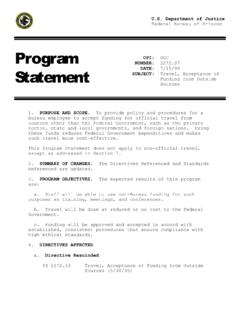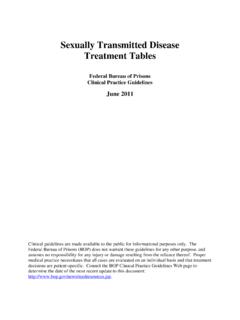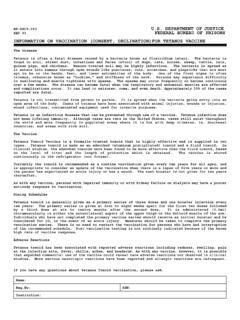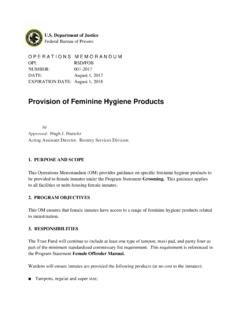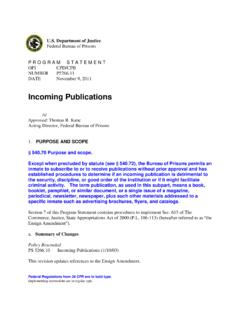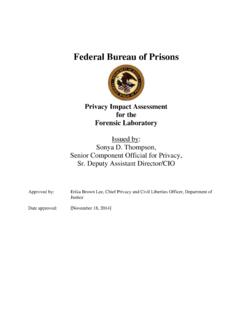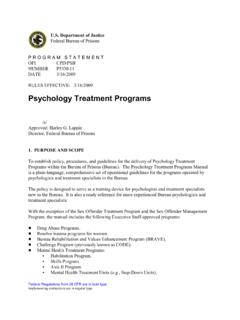Transcription of MANAGEMENT OF VARICELLA ZOSTER VIRUS (VZV) …
1 MANAGEMENT OF VARICELLA ZOSTER VIRUS (VZV) INFECTIONS Federal Bureau of Prisons Clinical Guidance DECEMBER 2016 Federal Bureau of Prisons (BOP) Clinical Guidance is made available to the public for informational purposes only. The BOP does not warrant this guidance for any other purpose, and assumes no responsibility for any injury or damage resulting from the reliance thereof. Proper medical practice necessitates that all cases are evaluated on an individual basis and that treatment decisions are patient-specific. Consult the BOP Health MANAGEMENT Resources Web page to determine the date of the most recent update to this document: Federal Bureau of Prisons MANAGEMENT of VZV Infections Clinical Guidance December 2016 i WHAT S NEW IN THIS DOCUMENT? What is new in the December 2016 version of this document? Duplication of information is minimized. VARICELLA IgM testing is not recommended for either suspected VARICELLA cases or contacts, because of low sensitivity and specificity (see Appendix 1, VARICELLA Testing).
2 Procedures for contact investigation have been simplified and clarified (see Appendix 3, VARICELLA Contact Investigation Checklist). VariZIG for post-exposure prophylaxis is now commercially available. What was new in the December 2011 version of this document? A digital VARICELLA Timeline Calculator (for determining the exposure and infectious periods of an index case and the incubation period of exposed contacts) was added to the BOP website ( ). Treatment of post-herpetic neuralgia associated with herpes ZOSTER was clarified (see Treatment of Herpes ZOSTER /Shingles in Section 6, Treatment). It was emphasized that inmates with herpes ZOSTER (shingles) should be housed in a single cell if the secretions from the lesions cannot be easily contained (see Housing Inmates with VARICELLA or Herpes ZOSTER in Section 7, Control Measures). Specific guidance regarding MANAGEMENT of employees exposed to VARICELLA was removed from this document and will be provided separately.
3 Information regarding the availability of VariZIG for inmates was provided in Appendix 5. A handout with practical advice for inmates with VARICELLA or herpes ZOSTER was provided in Appendix 6. Federal Bureau of Prisons MANAGEMENT of VZV Infections Clinical Guidance December 2016 ii TABLE OF CONTENTS 1. PURPOSE .. 1 2. EPIDEMIOLOGY OF VARICELLA ZOSTER VIRUS .. 1 3. OVERVIEW OF VARICELLA (CHICKENPOX) .. 1 Natural History .. 1 Presentation .. 1 TABLE 1. VARICELLA Diagnosis .. 2 Transmission .. 2 VARICELLA in Pregnancy .. 2 4. OVERVIEW OF HERPES ZOSTER (SHINGLES) .. 3 Natural History .. 3 Presentation .. 3 Complications .. 3 Transmission .. 4 5. 4 Treatment of VARICELLA /Chickenpox .. 4 Treatment of Herpes ZOSTER /Shingles .. 4 Antiviral Therapy .. 4 Additional Treatments for Herpes ZOSTER /Shingles .. 5 Herpes ZOSTER Ophthalmicus .. 5 Postherpetic Neuralgia (PHN).
4 5 Patient Education .. 5 7. HOUSING OF INMATES WITH VARICELLA OR HERPES ZOSTER .. 6 8. CONTACT INVESTIGATIONS/CONTACT MANAGEMENT .. 6 VARICELLA (Chickenpox).. 6 Herpes ZOSTER (Shingles) .. 6 DEFINITIONS .. 7 18 BREFERENCES .. 8 APPENDIX 1. VARICELLA TESTING .. 9 APPENDIX 2. ANTIVIRAL THERAPY FOR VARICELLA ZOSTER VIRUS (VZV) INFECTIONS .. 10 APPENDIX 3. VARICELLA CONTACT INVESTIGATION CHECKLIST .. 11 APPENDIX 4. VARICELLA VACCINE PROPHYLAXIS .. 15 APPENDIX 5. VARICELLA ZOSTER IMMUNOGLOBULIN (VARIZIG ) PROPHYLAXIS .. 16 APPENDIX 6. INMATE EDUCATION: CHICKENPOX AND SHINGLES .. 17 Federal Bureau of Prisons MANAGEMENT of VZV Infections Clinical Guidance December 2016 1 1. PURPOSE The Federal Bureau of Prisons (BOP) Clinical Guidance for the MANAGEMENT of VARICELLA ZOSTER VIRUS (VZV) Infections provides recommendations for the medical MANAGEMENT of federal inmates with VARICELLA (chickenpox) and herpes ZOSTER (shingles), as well as for prevention and control measures.
5 2. EPIDEMIOLOGY OF VARICELLA ZOSTER VIRUS VARICELLA ZOSTER VIRUS causes two distinct clinical conditions. Primary VZV infection causes VARICELLA (chickenpox), a contagious rash illness typically occurring among children. Years after the initial infection, VZV can reactivate to cause herpes ZOSTER (shingles), normally presenting as a unilateral, painful, vesicular rash that occurs in adults. Before the introduction of VARICELLA vaccine in the United States in 1995, almost all persons developed VARICELLA , with 90% of the cases occurring before age 15. Data indicate that 97% of born persons who were born between 1960 and 1980 are immune. In tropical and subtropical regions, VARICELLA more typically occurs in teenagers and adults; hence, foreign-born inmates are more likely to be susceptible to VARICELLA than born inmates. With increased vaccination coverage and decreased incidence of wild-type chickenpox, a higher proportion of chickenpox cases will be those that occur after vaccination as breakthrough disease.
6 Beginning at ages 40 50, incidence rates of herpes ZOSTER increase rapidly. Approximately 50% of persons who live to age 85 will experience shingles. 3. OVERVIEW OF VARICELLA (CHICKENPOX) NATURAL HISTORY VARICELLA , or chickenpox, is a highly contagious systemic disease that normally results in lifelong immunity. Persons with a prior history of VARICELLA , who are re-exposed to wild-type VZV, develop an asymptomatic reinfection that boosts VZV antibody titers, but rarely causes a second bout of chickenpox. PRESENTATION Chickenpox normally presents with mild constitutional symptoms and the sudden onset of a maculopapular rash that rapidly evolves to a vesicular exanthem. Adults may have 1 to 2 days of fever and malaise prior to rash onset. The rash classically spreads in successive crops, resulting in lesions appearing in various stages of evolution, including papules, superficial vesicles ( dew drops ), pustules, and crusted lesions.
7 Lesions are concentrated on the trunk, with fewer lesions on the distal extremities (but not involving the palms of the hands or soles of the feet). Federal Bureau of Prisons MANAGEMENT of VZV Infections Clinical Guidance December 2016 2 Atypical and subclinical cases of VARICELLA without a rash are rare, but do occur. Most cases of chickenpox are self-limited without serious sequelae. Life-threatening complications such as encephalitis, pneumonia, and hepatitis occur more commonly in newly infected adults and immunocompromised persons. Inmates presenting with vesicular rash should be evaluated for possible VZV infection, as described in Table 1 below. TABLE 1. VARICELLA DIAGNOSIS The diagnosis of chickenpox ( VARICELLA ) can be made or supported by any one or more of the following: (1) PHYSICAL EXAMINATION to identify the symptoms typical of VZV rash: Lesions that are simultaneously in all stages of development from vesicles on a red base, to umbilicated pustules, to crusted lesions.
8 (2) PATIENT HISTORY of exposure to VARICELLA or herpes ZOSTER in the past three weeks. (3) LABORATORY TESTS can be useful for confirmation of the diagnosis, particularly if the presentation is atypical: polymerase chain reaction (PCR) testing of vesicular fluid is the recommended test for VARICELLA . It is widely available from commercial labs (see Appendix 1, VARICELLA Testing). IgM testing is not recommended for diagnosis of VARICELLA . TRANSMISSION VZV infection is readily transmitted from person to person as follows: droplet SPREAD when a person with chickenpox coughs or sneezes. DIRECT CONTACT with upper respiratory secretions or with lesions that have not yet crusted. AIRBORNE SPREAD, which is more likely to affect immunocompromised individuals. CONGENITAL transmission. VARICELLA is highly contagious, with a secondary attack rate of 70 90% ( , rate of transmission from a chicken pox case to those previously uninfected).
9 For the definition of Significant Exposure, see Appendix 3, Step 4. VARICELLA IN PREGNANCY Pregnant women who get chickenpox are at increased risk for pneumonia and other life-threatening complications. If a pregnant woman develops VARICELLA in the first trimester or early in the second trimester, her baby has a small risk ( %) of being born with congenital VARICELLA syndrome. The baby may have scarring on the skin; abnormalities in the limbs, brain, or eyes; and low birth weight. If a woman develops VARICELLA rash in the period from five days before delivery to two days after delivery, the newborn will be at risk for neonatal VARICELLA . Currently, the mortality rate for neonatal VARICELLA is about 7%. Federal Bureau of Prisons MANAGEMENT of VZV Infections Clinical Guidance December 2016 3 4. OVERVIEW OF HERPES ZOSTER (SHINGLES) NATURAL HISTORY Following primary VZV infection, VARICELLA infection persists in a dormant state in the dorsal-root ganglia.
10 Reactivation of VZV infection results in herpes ZOSTER (shingles). Shingles occurs sporadically in otherwise healthy individuals, but more commonly affects the elderly and immunocompromised persons. PRESENTATION Herpes ZOSTER usually presents as a rash in one or two adjacent dermatomes. The rash most commonly appears on the trunk along a thoracic dermatome, and usually does not cross the body s midline. Approximately 20% of shingles patients develop a rash that overlaps adjacent dermatomes. Even less commonly, the rash can be more widespread and affect three or more dermatomes. This condition, called disseminated ZOSTER , usually occurs only in people with compromised or suppressed immune systems. Disseminated ZOSTER can be difficult to distinguish from VARICELLA . The rash is usually painful, itchy, or tingly. These sensations may precede the actual rash onset by days to weeks.
